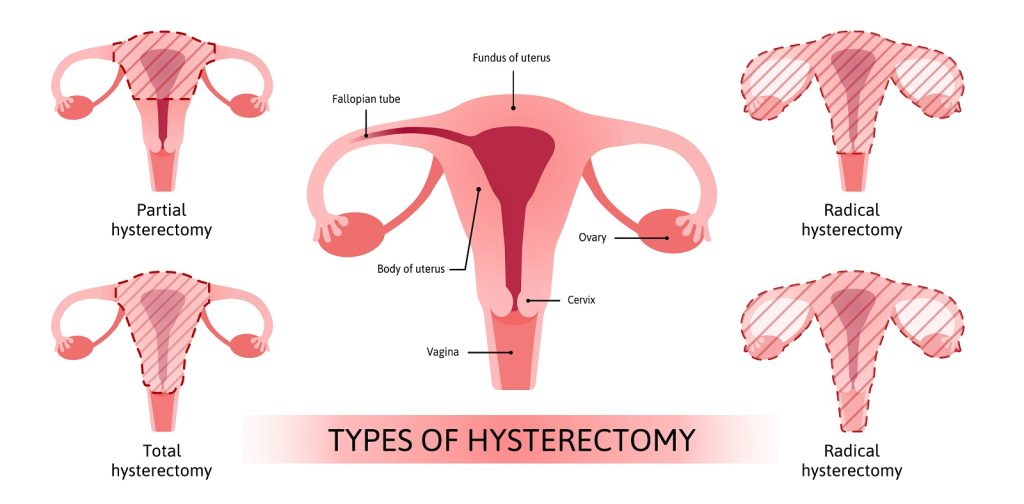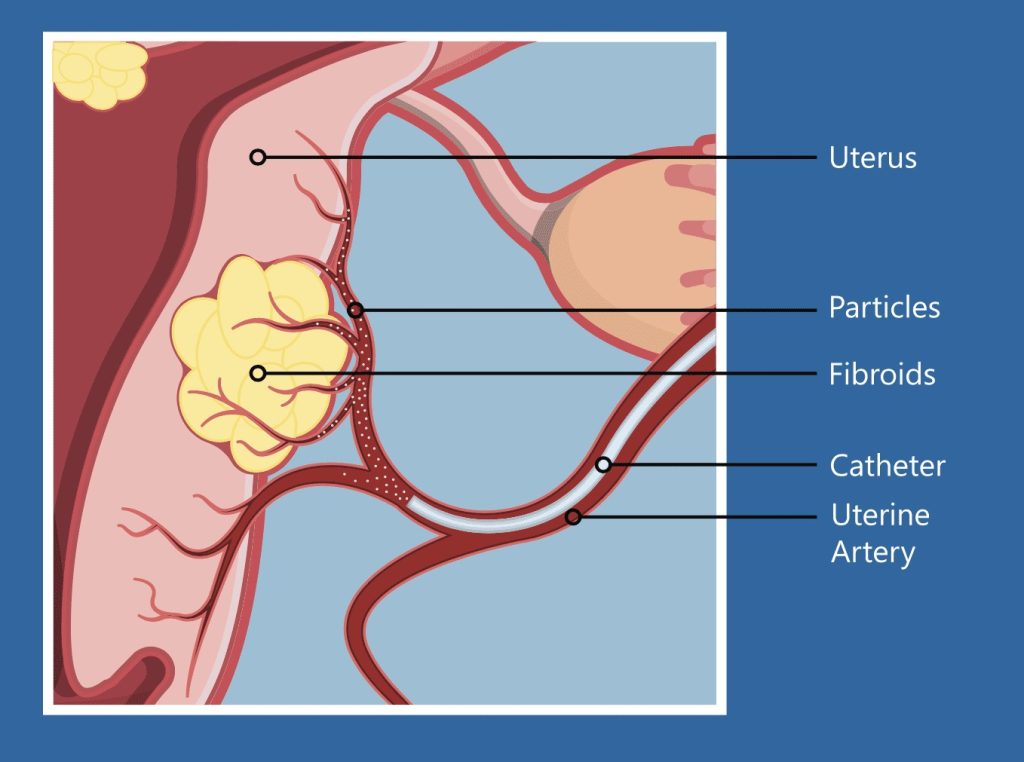Erica has been dealing with symptomatic uterine fibroids for roughly a year now. At first, she thought things would get better with time and patience. But now the pain is unbearable—and there doesn’t seem to be relief in sight. After doing some research online, “hysterectomy for fibroid removal” keeps popping up on her screen. However, she can’t help but wonder if surgery really is the best and only option.
The good news is that while having a hysterectomy for fibroid removal may be the only choice for some patients, it might not be necessary for women like Erica who are at their wit’s end with life-altering fibroids. There are fibroid treatment alternatives for a pain-free life without drastically affecting your body.
When Would a Hysterectomy be Needed for Fibroids?
A hysterectomy is a fibroid removal surgery that involves removing all or part of a woman’s uterus and, in some cases, the fallopian tubes and ovaries, depending on where her fibroids are located. Hysterectomy for fibroid removal is incredibly common, with approximately 600,000 hysterectomies being performed annually in the United States.
A hysterectomy for fibroid removal is generally recommended if a woman also:
- Has cancer of the uterus, cervix, vagina, fallopian tubes, and/or ovaries
- Is suffering from severe Pelvic Inflammatory Disease
- Has uncontrollable bleeding
- Is suffering from complications during childbirth
The important thing to note here is that while a hysterectomy for fibroid removal will eliminate the painful symptoms you’ve been experiencing, there are plenty of cons that could outweigh the positives. For example, recovery time from a hysterectomy can be six weeks or longer, depending on the surgical technique and your situation. It also eliminates the possibility of having children in the future and can cause other disruptions such as hormonal imbalances, depression, and changes in sexual feelings or sensations. If you are a challenging surgical case, a hysterectomy could cause unintended infections, an injury to the bowel or bladder, and even blood clots.
In addition, a hysterectomy for benign conditions does come with potential risks, including increasing your risk for heart disease, high blood pressure, obesity, high cholesterol, and coronary artery disease.

If a hysterectomy for fibroid removal is necessary, there are three types to consider:
- Total hysterectomy — This is also known as a complete hysterectomy and is the most invasive of the three options. It is designed to treat patients who have fibroids of various sizes embedded in multiple areas. Women who are facing the threat of cancer are also candidates. With this procedure, your doctor will remove the entire uterus along with the cervix and possibly the fallopian tubes and ovaries.
- Partial hysterectomy — Unlike a total hysterectomy where practically everything is removed, the cervix is left intact with this procedure. Instead, your doctor will only remove part of the uterus and possibly the ovaries. If the ovaries stay, it is possible that the patient could keep producing hormones until menopause.
- Radical hysterectomy — A radical hysterectomy is usually called upon for extreme cases where cervical or uterine cancer is present. With this procedure, everything is removed—the uterus, cervix and surrounding tissue, and the upper part of the vagina. The fallopian tubes and ovaries may or may not be removed.
All too often, however, hysterectomies are viewed by healthcare providers as a woman’s only option rather than searching for less-invasive alternatives. According to a study published in the American Journal of Obstetrics & Gynecology, as many as 1 in 5 women in the United States whose doctor recommended a hysterectomy don’t need one. Meanwhile, the same researchers found that 37.7% of women included in the study had no documentation indicating they underwent alternative treatment prior to undergoing a hysterectomy.
Can Fibroids Be Treated Without a Hysterectomy?
Yes, but what many women don’t realize is that there is a difference between fibroid removal and fibroid treatment. The only way to “remove” fibroids is through a surgical procedure such as a hysterectomy or myomectomy. Treatment options such as Uterine Fibroid Embolization (UFE) focus on shrinking and killing the fibroids rather than invasively removing them. By treating them with UFE, a woman can avoid a messy and painful surgery but still achieve highly successful results.
UFE is more than 90% effective in relieving fibroid symptoms mentioned earlier in this article. It achieves this by cutting off blood flow to all fibroids, causing them to shrink and die, so that you can get back to normal activities quickly. Our physicians use x-ray guidance to locate the vessels that supply blood to your fibroids. During the procedure, your doctor will make a tiny puncture on your wrist, where small particles are injected through a tiny catheter. They are introduced through the uterine arteries into the fibroid vessels, blocking the blood flow to the fibroids.

The procedure will last about one hour, and you will be asleep. You can resume light activities as soon as you feel up to it. Most women return to work in around a week.
The advantages of UFE at Fibroid Institute include:
- Non-surgical, minimally invasive treatment option for fibroids
- Less risk than fibroid surgery, with no blood loss
- In-office procedure instead of hospital stay needed for fibroid surgery
- Recovery time only 7-10 days versus 4-6 weeks for surgery
- No abdominal (belly) incision
- Uterus remains preserved
- Tiny wrist puncture, no need for vaginal access
- Avoids side effects of hormone therapies typically used to treat fibroids
- >90% improvement in fibroid-related symptoms
UFE is perfect for women who want to avoid surgery, keep their uterus, and enjoy a shorter recovery time. It also comes in handy for women who would consider a hysterectomy but can’t have surgery because they are considered a technically challenging case.
You Have Options for Fibroid Pain at Fibroid Institute
Fibroid Institute Texas—with Dallas fibroid doctors and Houston fibroid doctors—is your go-to source for education about uterine fibroids and minimally invasive procedures. Medical Director and Founder of Fibroid Institute, Dr. Suzanne Slonim, endorses Uterine Fibroid Embolization (UFE), the gold standard in non-surgical fibroid treatment. Even if a hysterectomy or myomectomy is your doctor recommended course of action for your unique situation, UFE can be used as a pre-surgical procedure to make your experience as seamless and successful as possible.
Thousands of women have had their fibroids symptoms treated with UFE. Request a free 10-15 minute phone screening to determine if you are eligible. After the screening, if you qualify for UFE, you can schedule your onsite or telehealth consultation with the fibroid experts you need in your corner.
Most major medical insurance providers cover the cost of UFE. Get started on a #FibroidFree life today by calling 214-838-6440 or completing the form below.
Fibroid Institute Dallas serves the North Texas area including Highland Park, University Park, Park Cities, Garland, Mesquite, Richardson, Dallas, Sherman, Addison, Carrollton, Plano, Frisco, McKinney, Allen, Fort Worth, Grand Prairie, HEB, Arlington, Hutchins, Irving, Duncanville, DeSoto, Cedar Hill, Lancaster, Cockrell Hill, and more.
Fibroid Institute Houston serves the South Texas area including Houston, Sugar Land, Katy, Webster, Clear Lake, The Woodlands, Universal City, Spring, Kingwood, Stafford, Conroe, Texas City, Cypress, League City, Bellaire and more.
Prior to starting any new treatment or if you have questions regarding a medical condition, always seek the advice of your doctor or other qualified health provider. This information is not a substitute for professional medical advice.
*Patient stories are true. Names and/or photos may be changed to protect patient confidentiality.

